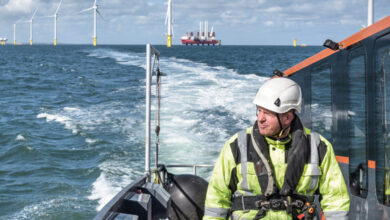Thierry Deschuyteneer: gas infrastructure stabilises energy
 Thierry Deschuyteneer, Executive Secretary of Gas Infrastructure Europe, highlighted its importance at the Northern Ireland Energy Forum.
Thierry Deschuyteneer, Executive Secretary of Gas Infrastructure Europe, highlighted its importance at the Northern Ireland Energy Forum.
Established in 2005, Gas Infrastructure Europe (GIE) represents the sole interest of the infrastructure industry in the continent’s natural gas business e.g. transmission system operators, storage system operators and LNG terminal operators. Its secretariat is in Brussels and it currently has 69 members in 25 countries.
Thierry Deschuyteneer was appointed as GIE’s Executive Secretary in October, after 10 years in Belgian TSO Fluxys. He was “honoured to be entrusted” with the management of the association and also “confident that GIE will continue to provide added value to the market and its members through the know-how and voluntary initiatives.”
Speaking at the Northern Ireland Energy Forum, Deschuyteneer noted the progressive “Europeanisation” of market access rules. Supply contracts are increasingly hub-based and gas flows at interconnection points between market zones are increasingly linked to price differentials between markets. Many issues, though, are still be resolved, including the optimal size of entry and exit zones and the increasing discrepancy between EU rules at interconnection points and internal rules. Network users are increasingly booking short-term capacity but investments require long-term signals.
Gas storage is a flexibility tool but is also in competition with other flexibility tools e.g. production and supply contract flexibility, interconnection points with adjacent networks, LNG re-gasification facilities and demand side management.
Despite the benefits that storage can bring, the capacity is currently not fully booked, meaning that stores were not full ahead of the winter. Suppliers are expected to provide their customers with gas in extreme climate conditions but demand for storage services is now lower than in previous years.
This is explained by price spreads being lower than storage tariffs. Storage is not sufficiently valued by the market. The role of gas in heating, industry and power generation is also under pressure after a decrease in demand in 2011-2012. However, he welcomed the recent recognition of the importance of gas and gas infrastructure in the Energy Infrastructure Package, the Connection Europe Facility and the first list of projects of common interest.
Deschuyteneer noted that gas could be part of the solution in transport e.g. using LNG to power small-scale maritime transport and heavy duty vehicles. Crucially, it also provides reliable back-up for variable renewable energy production.
Gas infrastructure is therefore a “no-regrets option” and provides security and diversification of supply, market integration, competition and liquidity. That said, the EU’s 2050 Energy Roadmap does not provide for the promotion of gas after 2035 and that will have a major bearing on whether infrastructure will be delivered.
Deschuyteneer’s concluding message was that policy objectives should remain stable. Regulators should interpret and apply rules in a consistent way, according to the legal framework, while learning from experience.





